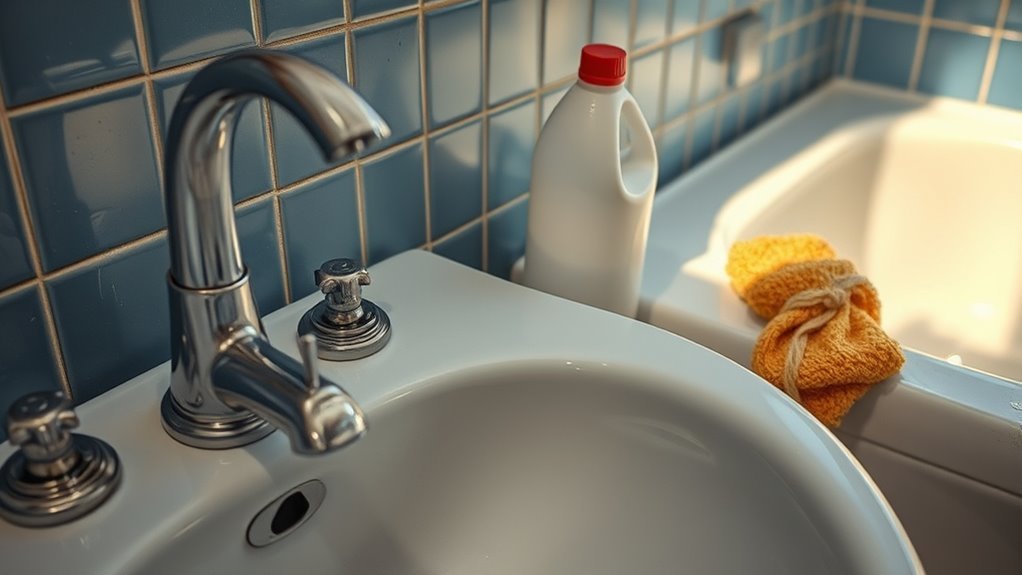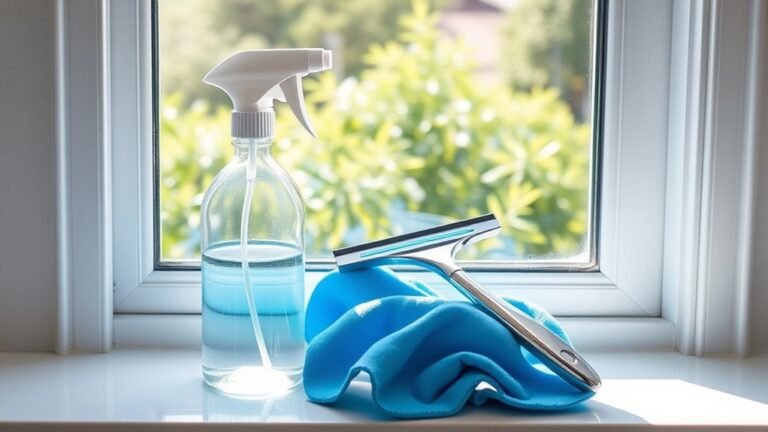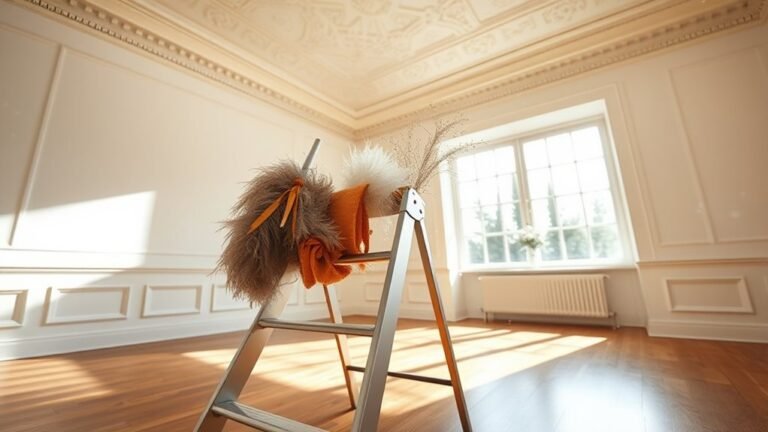Cleaning Mistakes That Damage Your Bathroom
You’re likely harming your bathroom by using harsh chemicals on delicate surfaces like natural stone, causing discoloration or etching. Scrubbing grout with abrasive tools can wear it down permanently, while skipping thorough rinsing leaves damaging residue. Overusing bleach may corrode metal fixtures and discolor tiles. Mold and mildew buildup from neglect can pose health risks and costly damage. Plus, choosing the wrong cleaners for natural stone ruins its finish. Understanding these errors helps protect your bathroom’s longevity.
Using Harsh Chemicals on Delicate Surfaces
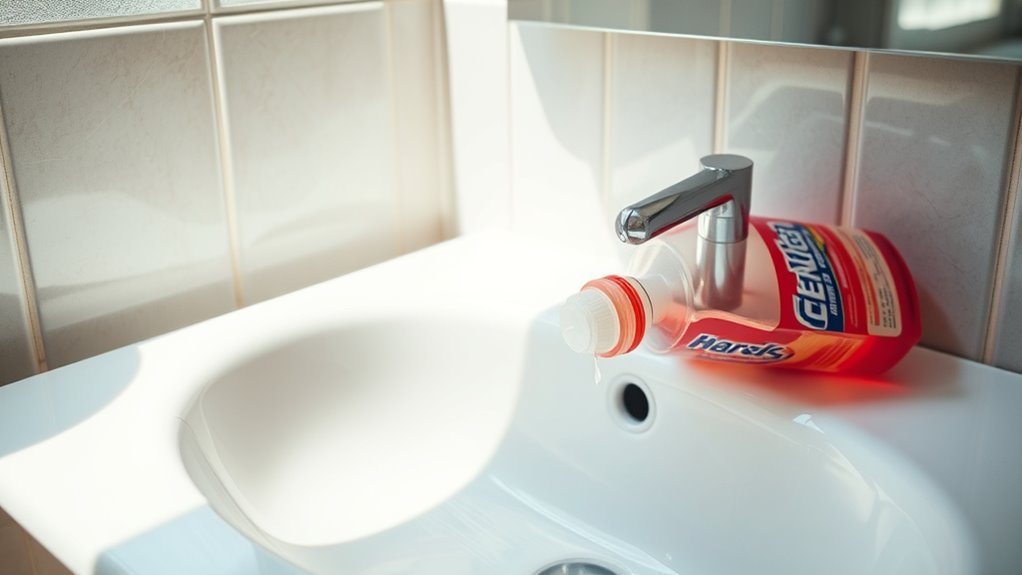
Although harsh chemicals might seem like a quick fix for bathroom grime, using them on delicate surfaces can cause irreversible damage. When you apply strong cleaners, unpredictable chemical reactions often occur, breaking down protective coatings or altering the surface’s integrity. This leads to discoloration, etching, or weakening of materials like marble, natural stone, or certain plastics. You might not notice the damage immediately, but over time, these reactions compromise durability and appearance. To maintain your bathroom’s freedom from costly repairs, you must choose cleaning agents specifically formulated for delicate surfaces. Avoid bleach and ammonia-based products that trigger aggressive chemical reactions. Instead, opt for gentle, pH-neutral solutions that clean effectively without risking surface damage. This careful approach preserves both your bathroom’s beauty and your peace of mind. Using surface-compatible products maintains cleanliness while protecting your bathroom’s longevity.
Scrubbing Grout With Abrasive Tools
When you scrub grout with abrasive tools, you risk wearing down the porous material and causing permanent damage. Grout is delicate and can erode quickly if treated harshly, which compromises its integrity and leads to costly repairs. Instead, follow grout maintenance tips that emphasize safe scrubbing techniques. Use a soft-bristle brush or a non-abrasive sponge to gently lift dirt without scratching the surface. Combine this with a mild cleaning solution designed specifically for grout to avoid weakening it. Avoid steel wool, wire brushes, or harsh scrubbing pads, as they strip away the protective layer and make grout more vulnerable. By adopting these careful methods, you maintain your grout’s durability and appearance, giving yourself the freedom to enjoy a clean, long-lasting bathroom without unnecessary damage. Additionally, regularly sealing your grout every one to two years helps protect it from moisture and stains, extending its lifespan and maintaining its appearance. This practice is an essential part of grout maintenance and sealing.
Ignoring Regular Mold and Mildew Removal
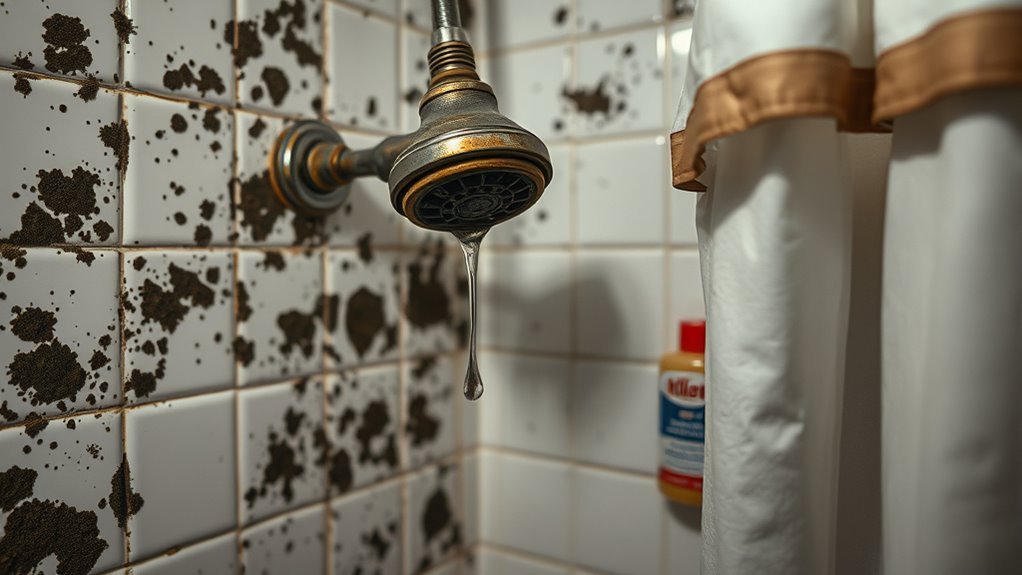
You might not realize how quickly mold and mildew can develop in your bathroom’s damp environment, posing serious health risks like allergies and respiratory issues. Ignoring regular removal allows these fungi to spread, compromising both your health and the integrity of your surfaces. To prevent this, you should routinely clean with appropriate mold-killing solutions and guarantee proper ventilation to keep moisture levels low. Using exhaust fans during and after showers is essential to reduce humidity and prevent mold growth.
Mold Growth Risks
Since bathrooms are constantly exposed to moisture, neglecting regular mold and mildew removal can quickly lead to significant mold growth. When you skip routine cleaning, mold spores settle and multiply, especially in hidden or damp corners. To prevent this, prioritize mold prevention by maintaining consistent humidity control. Use exhaust fans or dehumidifiers to keep moisture levels low, ideally below 50%. Regularly inspect grout lines, seals, and caulking for cracks where mold can establish itself. Cleaning with mold-inhibiting solutions and promptly drying wet surfaces reduces the risk. Remember, mold growth not only damages your bathroom’s surfaces but also leads to costly repairs. By methodically controlling humidity and removing mold early, you protect your bathroom’s integrity and preserve the freedom of a clean, safe environment.
Health Hazards
Ignoring regular mold and mildew removal in your bathroom can lead to at least three significant health hazards. First, prolonged exposure to mold spores increases respiratory issues, such as asthma and allergies, which can severely limit your freedom to breathe easily. Second, certain molds release mycotoxins that cause neurological symptoms and immune system suppression, presenting serious health risks. Third, when you use harsh chemicals to clean mold without proper ventilation, you risk inhaling toxic fumes, which can aggravate lung conditions and cause headaches. These health hazards don’t just affect you; they impact everyone in your household. Staying vigilant against mold and mildew is essential to maintain a safe bathroom environment. Neglecting this allows invisible dangers to compromise your well-being, restricting your ability to enjoy a healthy, unrestricted lifestyle.
Prevention Tips
Maintaining a mold-free bathroom requires consistent effort and attention to detail. Ignoring regular mold and mildew removal can lead to costly damage and health issues. To guarantee effective preventive maintenance, stick to a strict cleaning schedule. Here’s how you can stay ahead:
- Schedule weekly bathroom cleanings focusing on damp areas prone to mold growth.
- Use mold-resistant products and ventilation to reduce humidity.
- Inspect grout and caulking monthly, repairing cracks promptly to prevent moisture intrusion.
- Dry shower walls and floors immediately after use to minimize mold-friendly environments.
Overusing Bleach on Fixtures and Tiles
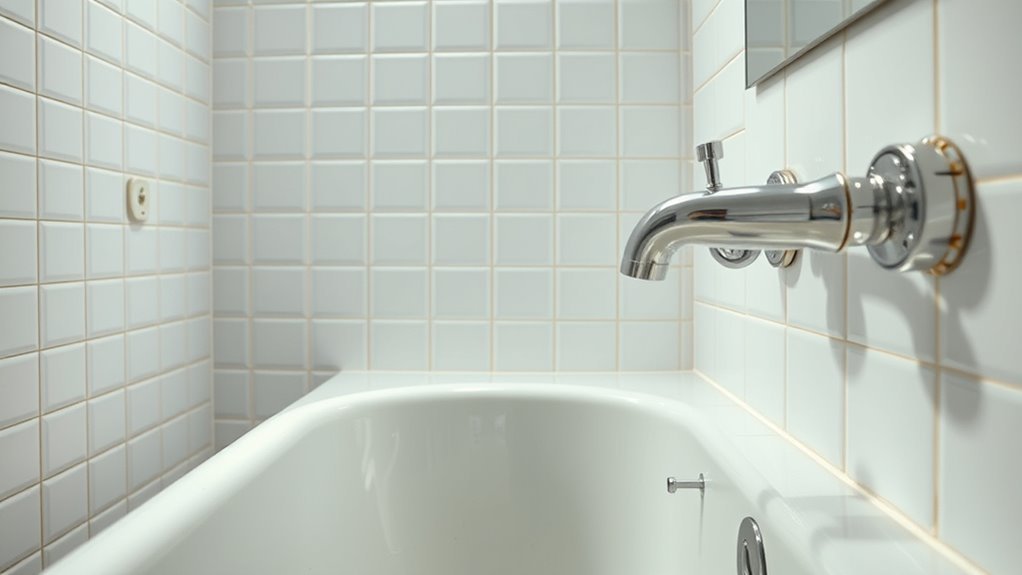
You might think that using bleach frequently on your bathroom fixtures and tiles is effective, but it can cause metal corrosion and damage finishes. Excessive bleach exposure can also lead to tile discoloration, weakening the surface over time. It’s important to balance cleaning power with the longevity of your bathroom materials.
Corrosion of Metal Fixtures
Although bleach is effective for disinfecting, overusing it on metal fixtures and tiles can lead to corrosion and damage. Understanding metal corrosion causes helps you protect your bathroom’s hardware. To avoid metal damage when cleaning, follow these steps:
- Limit bleach use to occasional deep cleans, not daily scrubbing.
- Rinse metal fixtures thoroughly after applying bleach to neutralize residue.
- Use milder, metal-safe cleaners for routine maintenance instead of harsh chemicals.
- Dry fixtures promptly to prevent prolonged exposure to moisture and bleach.
Tile Discoloration Risks
When bleach is overused on bathroom tiles and fixtures, it can cause noticeable discoloration and surface damage. You might think a strong cleaner guarantees cleanliness, but excessive bleach breaks down the tile’s finish, leading to fading or yellowing. To maintain your bathroom’s aesthetic freedom, it’s essential to apply tile maintenance tips that emphasize moderation and alternative cleaners. Instead of relying heavily on bleach, use pH-neutral solutions designed for tile surfaces. If discoloration has already occurred, explore color restoration techniques such as specialized color enhancers or professional refinishing services. These methods can revive tile vibrancy without further harm. By balancing effective cleaning with proper care, you preserve your bathroom’s look and avoid irreversible damage caused by harsh chemicals like bleach.
Neglecting to Rinse Cleaning Agents Thoroughly
Anyone who skips rinsing cleaning agents thoroughly risks leaving behind residue that can damage surfaces and cause discoloration. To protect your bathroom’s finish and maintain freedom from damage, adopt effective rinse techniques. Here’s how to avoid cleaning residue issues:
- Use lukewarm water to loosen and remove cleaner remnants without harming surfaces.
- Rinse in multiple passes, ensuring every area is free from suds or streaks.
- Wipe down surfaces with a microfiber cloth after rinsing to capture lingering moisture and residue.
- Avoid letting cleaning agents air dry, as this increases the chance of buildup and discoloration.
Using microfiber cloths for wiping helps prevent streaks and ensures a thorough clean.
Using the Wrong Cleaners for Natural Stone
Proper rinsing is only part of protecting your bathroom surfaces; using the wrong cleaners on natural stone can cause irreversible damage. Natural stone, such as marble, granite, or travertine, is sensitive to acidic or abrasive substances. When selecting cleaning products, always verify cleaner compatibility to prevent etching, discoloration, or dulling. Avoid acidic cleaners like vinegar or lemon-based solutions, which break down the stone’s protective seal. Instead, use pH-neutral, stone-specific cleaners designed to preserve the surface integrity. Test any cleaner on a small, inconspicuous area first to confirm it won’t harm the stone. By prioritizing cleaner compatibility and mindful product choice, you maintain your bathroom’s natural stone in pristine condition, preserving both its beauty and your freedom from costly repairs. Using gentle, non-abrasive cleaners helps protect delicate surfaces from damage and extends their lifespan.
Frequently Asked Questions
How Often Should I Deep Clean My Bathroom to Prevent Damage?
You should aim for a deep cleaning frequency of at least once a month to keep your bathroom in top shape. Regular deep cleaning tackles grime and mold buildup that daily cleaning misses. Alongside this, follow bathroom maintenance tips like wiping down surfaces weekly and checking for leaks. This methodical approach guarantees your space stays fresh and damage-free, giving you the freedom to enjoy a clean, worry-free bathroom without constant upkeep stress.
Can Using Vinegar Harm My Bathroom Fixtures?
You might wonder if vinegar effects could harm your bathroom fixtures. While vinegar is great for cleaning, its acidity can erode certain materials like natural stone or delicate finishes, reducing fixture longevity. To protect your freedom to clean safely, use diluted vinegar solutions and avoid prolonged contact with sensitive surfaces. Always test on a small area first, so you maintain your fixtures’ durability without sacrificing your cleaning effectiveness.
What Are Safe Alternatives to Bleach for Cleaning Bathrooms?
You can choose natural cleaners like baking soda, lemon juice, or hydrogen peroxide as safe, eco friendly options to replace bleach in your bathroom. These alternatives effectively tackle grime and mold without harsh chemicals. Simply mix baking soda with water for scrubbing or use lemon juice’s acidity to break down stains. This method lets you clean thoroughly while protecting your fixtures and the environment, giving you freedom from toxic fumes.
How Can I Protect Bathroom Surfaces From Water Damage?
Oh sure, just let water reign supreme and watch your bathroom turn into a swampy disaster zone! To keep that from happening, you’ll want to apply water resistant coatings on vulnerable surfaces—think of them as invisible armor. Combine this with proper moisture management by ensuring good ventilation and wiping down wet areas promptly. This way, you protect your bathroom’s freedom from decay and maintain a fresh, damage-free space.
Is Steam Cleaning Effective for Bathroom Maintenance?
Steam cleaning benefits your bathroom by effectively removing grime and killing bacteria without harsh chemicals. You’ll enjoy a deeper clean that’s eco-friendly and safe for most surfaces. To maximize results, use steam cleaning tips like targeting grout lines and avoiding prolonged exposure on sensitive materials. Remember, steam cleaning is excellent for maintenance but shouldn’t replace regular wiping to prevent water buildup and damage over time.
